To be honest, the only reference I had for Iowa was a song from the musical The Music Man, where the townspeople sing “Give Iowa a try.”
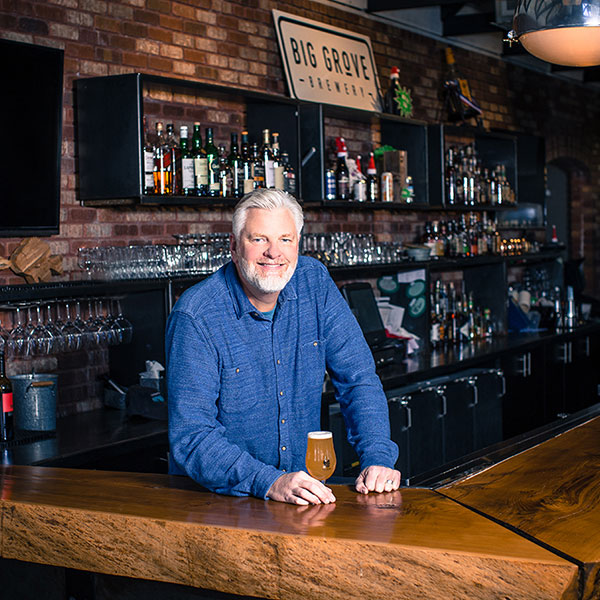
Doug Goettsch needed no such convincing. Having worked at the Culinary Institute of America in the Napa Valley as director of corporate relations for nearly two years (he spent almost two decades at Hawkeye Foodservice Distribution prior), he was ready to bid adieu to the culinary elite and return to Iowa’s familiar expanse of rolling plains, endless golden cornfields, and enormous clusters of wind turbines. I came to visit his Iowa home to study the anatomy of his business, celebrate a big beer release, and truthfully, share a beer with a friend—but what I didn’t expect was to fully see so much of a man’s soul poured into a pint. A place formerly known as Joensy’s Restaurant, “home of the biggest and best pork tenderloin in Iowa,” was the epicenter of Goettsch’s big plans.
Goettsch drives a big red pickup, a TRD 4×4 off road, with Big Grove on the license plate frame sporting the brewery’s logo: a mythical hybridized hop corn, combining his two real life takes of Iowa. When he picks me up in front of the airport, his size 15 sneakers tread the ground lightly and we pack the car.
Our first stop was Solon, a little town of a few thousand people. Solon has been home to Big Grove Brewery’s flagship brewpub since the business launched in August 2013. With seats for 150 (with 50 more on the patio during the summer), it’s been a nonstop small-town success story since the beginning. A host welcomes us in, as Goettsch stops to say hello and shake hands with every patron and employee in his path, slowly making his way to the Lilliputian 200-square-foot brewhouse in the back. Goettsch, who towers at 6′ 9″, offered to give me a tour of the original brewery. “Can you spin in a circle?” he joked. This was where it all began.
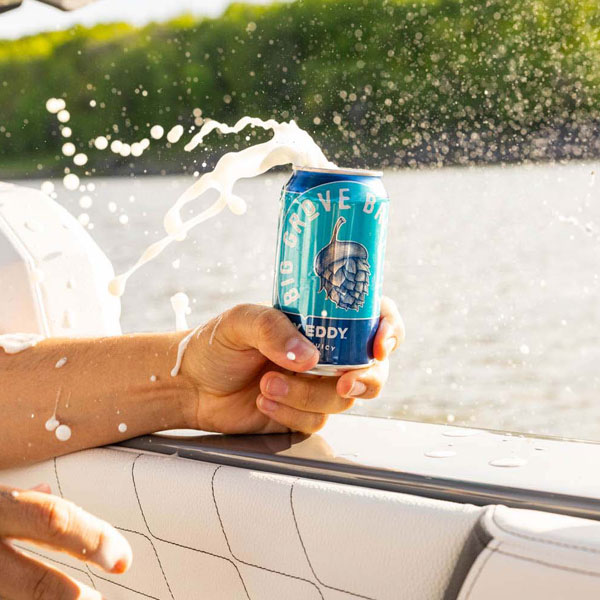
Goettsch is a hometown Hawkeye. He grew up here as the youngest of six with five older sisters, a quiet giant with well-coiffed white hair and a goatee. His vision was to create a literal big grove with his brewery by investing in Iowa—and so far, it’s worked. Big Grove has toppled Toppling Goliath as Iowa’s #1 craft beer brand (on sales)—led by its tropical fruit-forward Hazy IPA, Easy Eddy; became the official craft beer of the Iowa Hawkeyes (former NCAA superstar Caitlin Clark’s alma mater); and has now started to expand beyond state lines, set to open Big Grove’s fifth taproom in Omaha, Nebraska.
Whereas the Solon taproom is 5,000 square feet, the one in Iowa City is the largest food and beverage venue in the state with 26,000 square feet inside and another 25,000 outside—well over an acre. It holds 1,200 people at capacity.
“I don’t know a thing about beer,” Goettsch quipped. His partners actually sought him out and were already engrained here in Iowa. Son-mother duo Matt and Faye Swift came with a deep background in bars. Goettsch had known them from the industry, and certainly from drinking in their establishments. Faye opened Sluggers Neighborhood Bar & Grill, an instant classic in Coralville in 1988. Before the bar went under water, literally, during the Iowa flood of 2008, patrons imbibed pints on the reg. To carry on the family legacy, Matt took over Rookies in North Liberty in 2009, reborn as Reds, introducing craft beer to thirsty Hawkeyes. When the city denied their request to add on to the back of Reds, the seeds of Big Grove were planted.
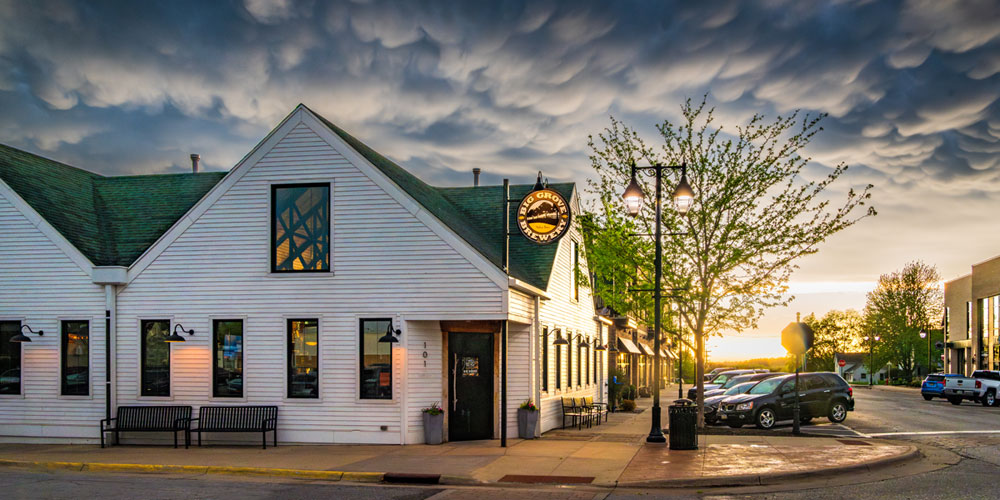
Next up was Nate Kaeding. Named Mr. Iowa as a football player before a career in the NFL with the San Diego Chargers, he was also Matt’s friend from elementary school. When hometown hero Kaeding invested in a series of Iowa City restaurants through his business Gold Cap Hospitality, in which Goettsch has partnered on some ventures (see: Pullman Bar & Diner, St. Burch Tavern, and and the revival of Hamburg Inn No. 2—a relic since 1930, where Reagan once sidled up for pie in ‘82 and now famous for its coffee bean caucuses since the early aughts), they ostensibly rooted themselves on familiar, fertile ground, raising the bar for what became a thriving culinary scene, but also added the necessary traplines to support local craft beer. Big Grove poured themselves into becoming that beer.
The Beer
Bill Heinrich was the first brewer at Solon. It was used as a pilot brewhouse, developing sours and lagers. Citrus Surfer, a citrus wheat now in lemon berry, lime, and watermelon iterations, is barely two years old and booming. Even before that were the Eddys: West Eddy, Easy Eddy’s West Coast variant; Royal Eddy, a 9% ABV imperial hazy IPA with an over-the-top amount of Citra and Talus dry hops; Big Ed, a double-hazy IPA with Sabro, Mosaic, and Simcoe; Freezy Eddy, a Cold IPA; and even Aussie Eddy, featuring peachy Australian-grown Galaxy and Enigma hops. For the locals, there’s a Boomtown golden ale brewed with Midwestern barley, and an Iowa City Lager, a Pilsner with German heritage. While Andy Joynt, Big Grove’s head brewer, isn’t in an arms race with other breweries (though BG’s Arms Race, an American strong pale ale, pokes fun at that phrase), he does make three to four new beers a week and has likely brewed over a few hundred in his time there. “We know where the line is, and we walk right on it,” Goettsch jests, once again summing it up.
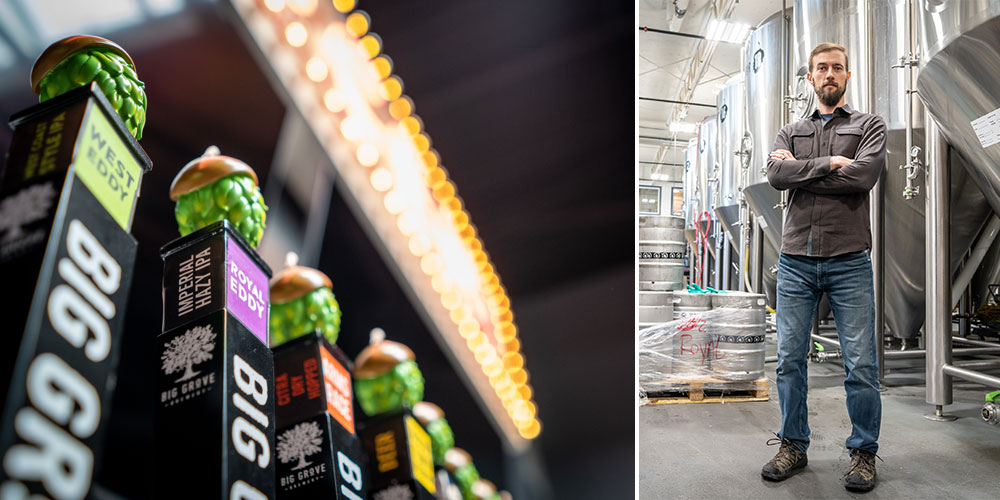
Quickly, Big Grove hit capacity, again and again, and Matt Swift knew it was time for (big) business. They expanded brewery operations from Solon to 30,000 barrels in Iowa City in 2017, recently tripling production at their Liberty Drive facility a couple years back, adding another 65,000 barrels to their volume, nearing the 100,000 max capacity as a whole. With 42,000 square feet to work with, including 30-foot high ceilings, 23-foot high tanks, and multiple massive silos that hold over 50,000 pounds of grain each, this place is one of the few things that dwarfs Goettsch. Big Grove bought most of the equipment from a Green Flash sale (eight fermenters, two brite tanks, a five-vessel brewhouse, and a centrifuge), which arrived in 18 semi-trucks, the sales and shipping costing nearly half a million dollars.
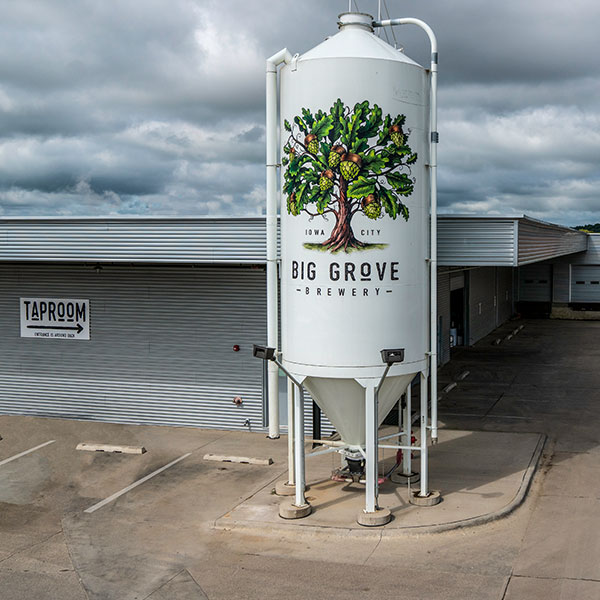
Aside from a dozen of their own tap lines, Big Grove pours through a thousand more, plus 100 handles in the Illinois market as they inch their beers closer to Chicago. Kansas City is next on tap. Hy-Vee, a grocery chain in the Midwest, proudly displays Eddy 12-packs and has been a big supporter, selling nearly 40,000 cases this year. “Within the state of Iowa, we’re probably going to finish around 365,000 cases, of which I would say our mix is 55% pack (cans), 45% draft, and 15% in-house,” commented Mike Wehr, Big Grove’s COO. “We are not selling more than Toppling Goliath in the nation, but we’re the #1 craft beer in Iowa.”
Richard The Whale
“Brewers do not brew, they are shepherds of yeast,” Ophelia Olson, a cellarwoman at Big Grove, told me. Olson’s former career was at a Montessori school, a job that was uniquely equipped to help her coax character out of cultures in the brewhouse. Olson is of Latin descent, bringing in flavors such as Mexican hot chocolate and churro banana stand to the mix. “Tembleque,” she explained, “is a [creamy] Puerto Rican eggnog.” All these adjuncts have found their way into Big Grove’s Richard The Whale, an 11-month-bourbon-barrel-aged Russian imperial stout. Its release is celebrated the first weekend of December every year in an entirely over-the-top way—from all-you-can-eat brunches to the much-coveted multi-course dinner created by Big Grove’s exceptional culinary team.
For the annual release, patrons usually start setting up tents shortly after midnight to get a first taste of Richard. At 6 a.m., in-line bottle trades usually begin, which Jared Walsh, a friend of the brewery and an ear, nose & throat doctor, loves participating in. Last year I found him sidled up to the bar in Iowa City, casually reciting the contents of his 150- to 200-bottle cellar to the staff. He even brought a vertical of past Richard The Whales, from 2018-22, to share with other enthusiasts, including me.
I noticed a few patrons down the bar lifting their shirts up to show off their tattoos. One guy named Cody had an orange whale on his arm, and another named Cody, a green one on his back alongside a couple dozen other brewery logos.
The Food
There are three parts to Big Grove’s blueprint, or as Goettsch refers to it, the Golden Triangle. Included in that Venn diagram are beer, food, and atmosphere, which essentially equates to hospitality.
Clearly beer is the primary concern, but the food served at Big Grove’s brewpubs has never been an afterthought. Culinary director and Iowa native Ben Smart, who cooked at Michelin-starred The Herbfarm in Woodinville, Washington, came home for an interview at Kirkwood Community College to work in its culinary program, but instead, Goettsch hired him first (Goettsch had worked with Smart’s dad at Hawkeye Foodservice Distribution decades before). Big Grove’s executive chef Sean Towley, a Kirkwood grad himself; Chris Crissinger-Vurciaga, chef de cuisine at Cedar Rapids who’s been with the company since day one; and TJ Lytle, chef de cuisine in Solon, the only person on staff even close to Goettsch in stature, are among the key culinary personnel who complete Big Grove’s mission.
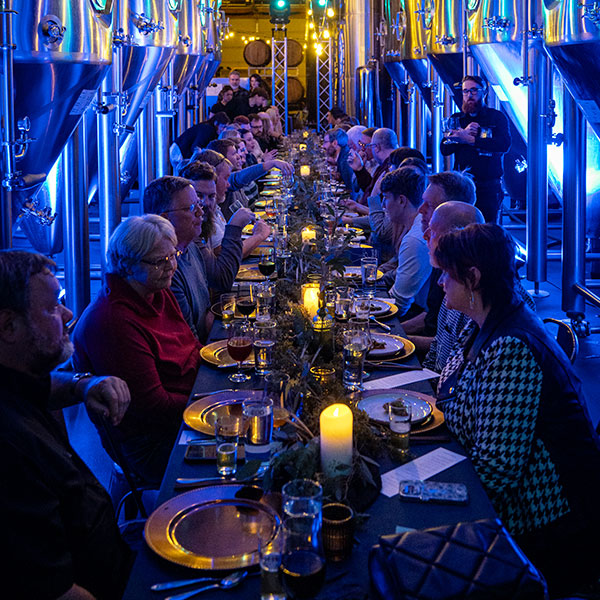
Pictures of British chef Marco Pierre White and French chef Auguste Escoffier hang on the kitchen wall at Iowa City. Flash-fried brussels sprouts, slicked with a honey sriracha vinaigrette and topped with toasted almonds and cilantro, are a best seller across all of Big Grove’s menus, as are the behemoth Bavarian pretzels served with Sherman Hill Champagne (a light lager) beer cheese; breaded and fried crispy cauliflower done in the style of Buffalo wings (they have those too!), dunked in ranch or blue cheese; and Goettsch’s stovetop mac & cheese, which he’s been making since he was 11 years old for “second supper” as he calls it. On the menu in Solon appears “the Dougie,” a combination of mac & cheese with tater tot casserole. This is all part of the ethos: “middle of the menu approachable, everything around the edges changes people’s perspectives,” Goettsch explains. That’s why you see tuna poke bowls and paneer curry pop up on tables.
“The bar here was so low,” Goettsch grumbles, “but no one’s going to buy an expensive entrée unless there’s trust; the middle menu has to be identifiable.” But that’s not to say Big Grove doesn’t flex its culinary prowess too. Once a year, during the Richard The Whale release, Smart and the team of chefs devise dishes for a special dinner that goes beyond brewpub fare. Last year’s dinner included a scallop crudo with grapefruit, sage brown butter, and 25-year-aged balsamic vinegar, a 45-day dry-aged prime ribeye with cherry kosho, smoked soy sauce and shiso, and a cool Tropical Fool, with coconut and banana diplomat cream, guava granite, and Hemingway daiquiri fruit salad. “Don’t tell people how to eat; let them discover,” Goettsch says.
The Hospitality
There’s a mantra I’d heard from multiple Big Grove employees across my three days with them: the goal isn’t to make money today, but to make people come back tomorrow. Wehr told me their new 10-year goal is set at $100 million in revenue. They’re a third of the way there.
“Growth is not just for the brand, it’s for the team—our goal is to expand and matter.” Goettsch chimed in on the growth strategy: “A mile deep, an inch wide.” In the brewpubs, bartenders are encouraged to find a reason to buy a guest a beer and make a connection.
This generous philosophy is knit into the philanthropy arm of the business as well. Big Grove For Good, which was formalized five years ago, partners with local nonprofits to help grow and strengthen their communities by reinvesting in the brewery’s roots. Drinking locally is also giving back.
I met a bunch of Big Grove employees at George’s Buffet, an Iowa City staple since 1939 with a huge Hamms mural on the parking lot wall. It’s a Saturday night football game. We have hamburgers in waxed paper sleeves. A sales rep stands for the team toast of Fireball shots. The next morning I find myself at church with Goettsch.
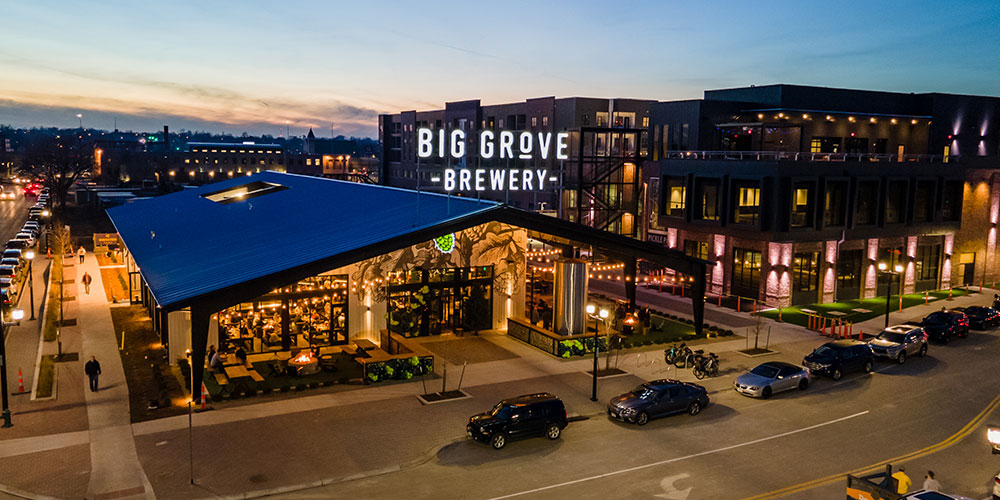
As organs echo, we read the bold type in the prayer book in unison and say amen together. Goettsch handed me a Dunn Brothers coffee cup and waved to friends from the mezzanine where we sat separate from the congregation. His wife, Sarah, the pastor, gave her sermon from the pulpit. She spoke of the Japanese art of kintsugi, a method of repairing cracked or broken ceramics with melted gold. She emphasized imperfections: “Cracks make us beautiful—our brokenness makes us unique.” As Sarah explained, “weak vessels break, strong vessels can also break but can be mended.”
Goettsch is the glue that holds Big Grove together. Is beer the gold that fills our fractures and makes us whole again? Or are we just trying to find the glimmering gold in people? Doug sips his coffee, turns to me and says, “And also with you.”
CraftBeer.com is fully dedicated to small and independent U.S. breweries. We are published by the Brewers Association, the not-for-profit trade group dedicated to promoting and protecting America’s small and independent craft brewers. Stories and opinions shared on CraftBeer.com do not imply endorsement by or positions taken by the Brewers Association or its members.
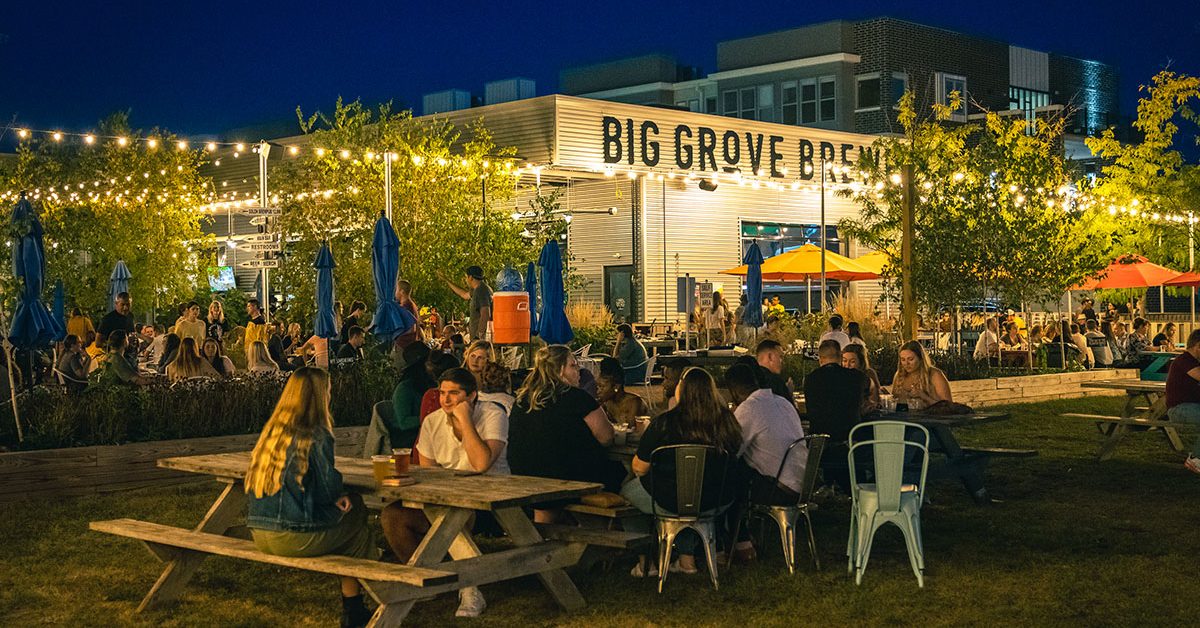

Share Post